0203-thai Art Emerald Buddha Statue Meditation Amulet Green Old Gem Gold Armor
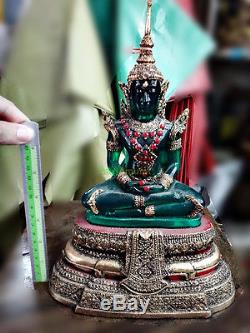
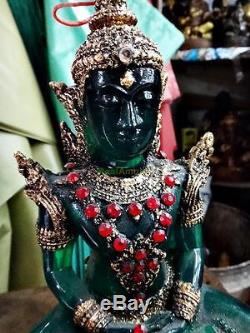
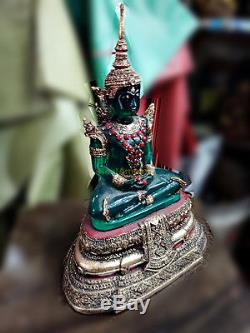
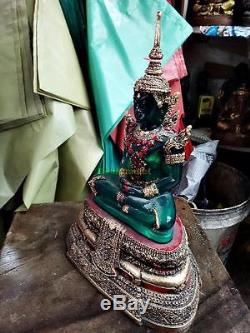
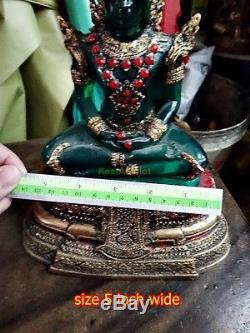
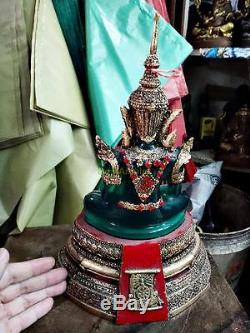
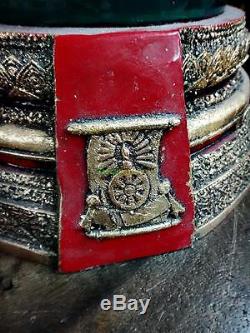

Genuine & Authenic, Made in thailand, Powerful and Really good effective. See my other Whole sale items at HERE. THAI ART EMERALD BUDDHA STATUE MEDITATION AMULET GREEN OLD GEM GOLD ARMOR. WAT Pha-Kew ANCIENT MONKS Blessing. Bizs: Bring more power to govern people or organization.
Item Received direct from temple. New condition but made in old look. This statues are made by resin.The mold unique design from artist. He created by handmade and finish each statue individually by himself. This process includes sanding, polishing, painting and a final polish to give the statue that extra shine. SUMMER ARMOR EDITION, SEAT 5 INCH WIDE, THIS STATUE DEPICTS A SEATED MEDITATING BUDDHA.
THAT IS SYMBOLIZES OF PEACEFUL. BELIEVED BUDDHA STATUE WILL BRING GOOD LUCK TO YOUR HOME SO IT GOOD FOR DECORATIVE, DISPLAY IN & OUT DOOR. This is a very fine amulet piece, it was incantation and bless with Good powerful magic.
Thailand's amulets are becoming very popular today because believed magic amulet worn by people to protect themselves from negative energies, evil and injury, and also brings Lucky, Wealth with a supernatural power of ancient magic inside. Million of thailand people (Celebrities, politician, athlete, Businessman, etc) still believed in Sacred Amulet will help who worship pass bad situation and resolved all crisis in life. It also protect Evil or Bad spirit can not back to attack you in future. It is a mantras phonetic Praying word to consecrate and control power of this item.
If temple give khata with item. History The Wat Phra Kaew chapel where the Emerald Buddha is now kept in Bangkok Historical sources indicate that the statue surfaced in northern Thailand in the Lannathai kingdom in 1434.
One account of its discovery tells that lightning struck a chedi in Wat Pa Yia (Bamboo Forest Monastery, later renamed Wat Phra Kaew) in the Chiang Rai, revealing a Buddha covered with stucco inside. The Buddha was then placed in the abbot's residence, who later noticed that stucco on the nose had flaked off, revealing a green interior. The abbot removed all the stucco and found a Buddha image made of a green semi-precious stone, which became known as Phra Kaew Morakot or the Emerald Buddha. "Emerald" here simply means "green coloured" in Thai.
[5][6] Some art historians describe the Emerald Buddha as belonging to the Chiang Saen Style of the 15th century AD, which would mean it is of Lannathai origin. Wat Phra Kaeo in Chiang Rai, where the Emerald Buddha was found King Sam Fang Kaen of Lannathai wanted it in his capital, Chiang Mai, but the elephant carrying it insisted, on three separate occasions, on going instead to Lampang. This was taken as a divine sign, and the Emerald Buddha stayed in Lampang in a specially-built temple for the next 32 years. In 1468, it was moved to Chiang Mai by King Tiloka, where it was kept in a niche in a large stupa called Chedi Luang. [7] The Emerald Buddha remained in Chiang Mai until 1552, when it was taken to Luang Prabang, then the capital of the Lao kingdom of Lan Xang.Some years earlier, the crown prince of Lan Xang, Setthathirath, had been invited to occupy the vacant throne of Lannathai as his mother was the daughter of the king of Chiang Mai who had died without a son. [7] However, Prince Setthathirath also became king of Lan Xang when his father, Photisarath, died.
Haw Phra Kaew in Vientiane In 1564, King Setthathirath moved it to Vientiane, which he had made his new capital due to Burmese attacks and where the Buddha image was housed in Haw Phra Kaew. [8] The Buddha image would stay in Vientiane for the next 214 years. [7] In 1779, the Thai General Chao Phraya Chakri put down an insurrection, captured Vientiane and took the Emerald Buddha to Siam.
It was installed in a shrine close to Wat Arun in Thonburi, its new capital. Chao Phra Chakri then took over the reins and founded the Chakri Dynasty of Rattanakosin Kingdom.He adopted the title Rama I and shifted his capital across the Menam Chao Phra river to its present location in Bangkok, and constructed the new Grand Palace including Wat Phra Kaew within its compound. Wat Phra Kaew was consecrated in 1784, and the Emerald Buddha was moved with great pomp and pageantry to its current home in the Ubosoth of the Wat Phra Kaew temple complex on 22 March 1784.
Legends View of the Emerald Buddha on its pedestal The legend of the Emerald Buddha is related in number of sources, in particular Ratanabimbavamsa or The Chronicle of the Emerald Buddha written in Pali by Brahmarjapañña in the 15th century. [9] The story is a mix of fact and fables with some variations to the story. [10] According to the legend, the Emerald Buddha was created in India in 43 BC by a saint in India named Nagasena in the city of Pataliputra (today's Patna).
Nagasena was said to have made the Emerald Buddha image made with the help of Hindu god Vishnu and demigod Indra, 500 years after Buddha attained Nirvana. He was said to have predicted that:[2] The image of the Buddha is assuredly going to give to religion the most brilliant importance in five lands, that is in Lankadvipa (Sri Lanka), Ramalakka, Dvaravati, Chieng Mai and Lan Chang (Laos). The legends state that after remaining in Pataliputra for three hundred years, it was taken to Sri Lanka to save it from a civil war. A version of the legend stated that in 457, King Anuruth of Burma sent a mission to Ceylon to ask for Buddhist scriptures and the Emerald Buddha, in order to support Buddhism in his country.When the Thais captured Angkor Wat in 1432 (following the ravage of the bubonic plague), the Emerald Buddha was taken to Ayutthaya, Kamphaeng Phet, Laos and finally Chiang Rai, where the ruler of the city hid it until it was found in 1434. The image The Buddha image is made of a semi-precious green stone, [1] described variously as jade or jasper rather than emerald, [3][11] as "emerald" here refers to its colour rather than the stone. [12] The image has not been analyzed to determine its exact composition or origin.
The figure is 19 inches (48 cm) wide at the lap, and 26 inches (66 cm) high. [4] The Buddha is in a seated position, with the right leg resting on the left one, a style that suggest it might have been carved in the late Chiangsaen or Chiangmai school, not much earlier than the fifteenth century A. However, the meditation pose of the statue was not popular in Thailand but looks very much like some of the Buddha images of Southern India and Sri Lanka, which led some to suggest an origin in India or Sri Lanka.Seasonal attire Closeup of Emerald Buddha in summer season attire The Emerald Buddha is adorned with three different sets of gold seasonal costume; two were made by Rama I, one for the summer and one for the rainy season, and a third made by Rama III for the winter or cool season. [7] The clothes are changed by the King of Thailand, or the Crown Prince in his stead, [13] in a ceremony at the changing of the seasons in the 1st Waning of lunar months 4, 8 and 12 (around March, August and November).
[14] For the three seasons, the three set of costumes for the Emerald Buddha:[1][14] Hot season - a stepped, pointed headpiece; a breast pendant; a sash; a number of armlets, bracelets and other items of royal attire. All items are made of enameled gold and embeded with precious and semi-precious stones. Rainy season - a pointed headpiece of enameled gold studded with sapphires; a gold-embossed monk's robe draped over one shoulder. Cool season - a gold headpiece studded with diamonds; a jewel-fringed gold-mesh shawl draped over the rainy season attire. The sets of gold clothing not in use at any given time are kept on display in the nearby Pavilion of Regalia, Royal Decorations and Thai Coins on the grounds of the Grand Palace, where the public may view them.
Worship and ceremonies Early in the Bangkok period, the Emerald Buddha used to be taken out of its temple and paraded in the streets to relieve the city and countryside of various calamities (such as plague and cholera). However, this practice was discontinued during Rama IV's reign as it was feared that the image could get damaged during the procession and also a practical line of thinking that Rama IV held "that diseases are caused by germs, not by evil spirits or the displeasure of the Buddha".
[2] The image also marks the changing of the seasons in Thailand, with the king presiding over the seasonal ceremonies. It is a significant ritual held at this temple three times a year, whereby the dress of the deity is changed at the start of each of the three seasons.
The astrological dates for the ritual ceremonies, at the changing of the seasons, followed are in the 1st Waning Moon of Lunar Months 4, 8 and 12 (around March, July and November). Rama I initiated this ritual for the hot season and the rainy season, Rama III introduced the ritual for the winter season.
[2][12] The robes, which the image adorns, represents that of monks and the King, depending on the season, a clear indication of highlighting its symbolic role "as Buddha and the King", which role is also enjoined on the Thai King who formally dresses the Emerald Buddha image. [3] The costume change ritual is performed by the Thai king who is the highest master of ceremonies for all Buddhist rites. During the ceremony, the king first climbs up to the pedestal, cleans the image by wiping away any dust, and changes the gold headdress of the Emerald Buddha. The king then worships nearby while an attendant performs the elaborate ritual of changing garments. [14] The king also sprays lustral water upon his subjects waiting outside the ordination hall, a privilege previously afforded only to the princes and officials who were attending the ceremony inside the ubosoth.[7] Ceremonies are also performed at at the Emerald Buddha temple at other occasions such as the by Chakri Day (begun on April 6, 1782), a national holiday to honour founding of the Chakri dynasty. The King and Queen, entourage of the royal family as well as the Prime Minister, officials in the Ministry of Defence, and other government departments, offer prayers at the temple.
Stock Photo of item(s). 100% guarantee about condition detail will similar as you see.(this process may take 2-3 day for take a photo). Due to many type of monitors, the actual color may be a little bit different as shown.
Allow 1-2 week for Asia Australia. Allow 3-4 week for Usa. Allow 4-6 week for Canada South-America.
I don't want to fix trouble because this misunderstand. This estimate time calculate average from my 10 years experience, some package will faster but some package may slower.
Damaged or incorrect item received. I will resend new one to replacement. I will do by best for fixed our problem in 48 hr. THAI ART EMERALD BUDDHA STATUE MEDITATION AMULET GREEN OLD GEM GOLD ARMOR >> WAT Pha-Kew ANCIENT MONKS Blessing >> Bizs: Bring more power to govern people or organization >> Plastic or Fiber glass >> Brand new (never use) >>!! The item "0203-THAI ART EMERALD BUDDHA STATUE MEDITATION AMULET GREEN OLD GEM GOLD ARMOR" is in sale since Sunday, May 01, 2016.
This item is in the category "Collectibles\Religion & Spirituality\Buddhism\Statues & Figures". The seller is "realamulet" and is located in Thailand's Temple.This item can be shipped worldwide.
- Country/Region of Manufacture: Thailand
- Material: Resin

